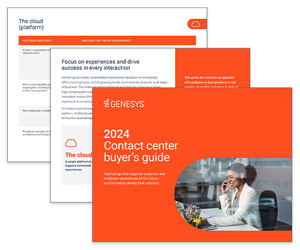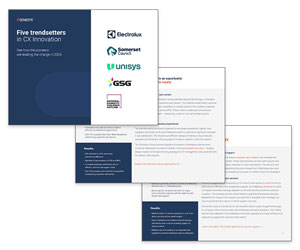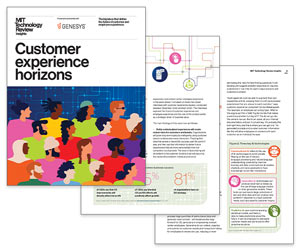We have crowd-sourced 20 fascinating predictions for what the contact centre could look like in ten years’ time.
First, we asked two experts in the field for their predictions.
1. Easy is the new loyalty
In the last three years, we have witnessed a decline in customer loyalty, with 50% of UK residents now claiming that loyalty is a thing of the past. However, 74% of people say they will do repeat business with a company if the experience is easy.
In reaction to this, the NetEasy Score has been developed. This new scoring system will allow companies to measure how easy customers are finding their services, and in turn how likely they are to do repeat business with them.
NetEasy data is gathered by asking customers to rate the ease of their experience on a scale of 1-7. Analysis of these scores can be used to re-evaluate your business processes and ensure that the customer experience is as easy as possible. Addressing areas of difficulty can be well worth your while, too, as BT have found that customers who find their services easy are 40% less likely to switch.
In the contact centre environment, it is important that you make your processes as simple as possible to minimise customer effort. If you find that you are getting consistently low NetEasy scores, ask yourself: Are your agents knowledgeable? Is it easy to get through to the right department? Is your process time-consuming? All of these factors will determine the ease of your customers’ experience, and you can’t afford to make it complicated.
2. Omnichannel contact will accelerate
The use of traditional channels, such as phone and email, will decrease, with email being commonly thought of as a slow-moving (and largely inefficient) game of tennis. Meanwhile, newer channels, including webchat, Twitter and video conferencing, will increase in popularity.
With one in two customers saying they constantly change the way they deal with organisations, it is no surprise that we are moving towards an age of omnichannel contact. The challenge is how to handle these channels effectively to ensure that customers don’t have to repeat their problem every time they switch channel.
3. Webchat, not social media, will be the biggest growing channel
Given that 9 in 10 consumers want support whilst online, and that webchat grants them access to this help without them having to come away from their device, this prediction seems highly probable.
The success of this channel is evident in the fact that 82% of customers have rated their experience of webchat as good or very good, whilst 26% of customers currently use webchat as their preferred contact channel.
Yet the benefits of webchat extend far beyond keeping the customer happy, as BT have noted a 60-70% increase in cross-sell/up-sell success whilst using this channel.
In addition, 88% of advisors rate webchat as good or very good. This is because it allows them to discuss problems with other advisors without putting the customer on hold, and removes the need for small talk.
4. Smartphones will fundamentally change behaviours
In the UK, 62% of people own a smartphone which grants them instant access to the internet. This increased level of accessibility has created a new generation of customer – dubbed “monster customers” – who expect a 24/7 customer service experience, whilst having the power to Tweet (and cause a PR nightmare) should their demands not be met.
It seems inevitable that as the smartphone generation ages, the way that customers interact with businesses will continue to change and grow.
5. The contact centre model will change
A survey has revealed that 49% of customers now only call a contact centre when they have a complex question. Yet the contact centre model wasn’t designed for complexity and needs to adapt if it is to survive.
The strain on the current contact centre model is evident in the fact that 85% of consumers say they have been put on hold because employees don’t know what to say, whilst an alarming 58% of consumers have reported that they have received better help from other customers than from employees.

Dr Nicola Millard
It is possible that companies will handle this new level of complexity through the concept of “the networked expert in action”.
This idea stems from the fact that experts can be anyone anywhere – as the cloud has enabled anyone to access a browser from any location. It is also likely that we will witness a merger of the back and front office, as back-office expertise will become increasingly in demand.
With thanks to Dr. Nicola Millard, Customer Experience Futurologist at BT
6. Contact centres will move into the cloud
It is very difficult to keep a contact centre simple (and running smoothly) given the sheer number of customers and amount of technology involved. In the past, attempts to get all of these systems to co-ordinate has let us down badly.
My vision for the future is for an integrated cloud-based software system, which will enable the contact centre and back-office team to work together, and for promises to customers to be fulfilled regardless of which agent makes them.
Through the use of unified communications – the integration of real-time communication services such as instant messaging with non-real-time communication services such as email – and business process automation internal processes can be organised and simplified, to everyone’s benefit.
7. There will be an increase in mobile supervisors
Advances in technology are making it increasingly easy for contact centres to operate outside the confines of an office.
I predict that through the use of a single management system (accessible as an app on a smartphone or tablet), supervisors will be able to monitor their agents via real-time stats (i.e. average call handling time, agent availability, etc…) without being limited by geographical location.
8. A single view of the customer will be achieved
This one has long been on the wish list for contact centres managers.
In the future, there will be a customer information depository within the contact centre, which will hold a complete record of every interaction the individual has had with the business. This will include everything from call recordings and email correspondence to the time spent on the website and the number of orders made. This is currently difficult to achieve as it requires integration of both synchronous and asynchronous information.
However, this information will be incredibly useful in the future. It will allow agents to form a better understanding of the customer in the moments before they answer the call. In addition, it will enable trends in customer behaviour to be identified and give managers an indication of when customers may be about to switch providers.
9. Mobile customer care will become standard practice
The customer service sections of smartphone apps are currently a bit of an anticlimax, as the majority suggest that you either phone or email the contact centre.
I think we will see a revolution in the way that mobile apps and the contact centre interact. The smartphones of the future will support online and video chat, as well as provide a “click to call” service and enable customers to make call-back requests.
10. The introduction of transparent contact centres
This is a revolutionary concept which will grant customers access to real-time information on ratings and availability and subsequently allow customers to pick the agent that they want to connect to.

Mike Murphy
For example, Mr. Customer has bought an expensive camera but has noticed that it isn’t showing all the pixels on the screen. He looks online at the transparent contact centre and sees that John Doe has a 5* rating for fixing problems with his exact model of camera. He then chooses to click through to John Doe to resolve his problem.
The customer will also be able to opt out of the selection process and choose to speak to the next available agent.
With thanks to Mike Murphy, Senior Account Executive at Genesys
Here are ten more predictions from our readers…
11. Avatars will become more prominent
Avatars will become more prominent, although actual video conferencing with agents is unlikely.
There will also be a growth in Virtual-Assistants or Chat-Bots.
With thanks to Thomas and Deon
12. Everyone will become experts
We will make our customers the experts and they will be able to answer each other’s queries.
There will also be less scripting within contact teams and more focus on developing their EQ – Emotional Quotient – skills. This will help agents to achieve ‘balance’ with irate and unhappy customers, achieve better resolutions and minimise escalations.
With thanks to Glenn and Scott
13. A large proportion of the contact centre will work from home
A large proportion of the contact centre will work directly from home.
In particular, home-workers will be used to support peak periods in the contact centre.
With thanks to Mohamed and Adam
14. Technology will monitor how our agents are feeling
We will use technology to monitor how our front-line agents are feeling. This will allow managers to actively improve staff well-being.
I believe the old saying ‘happy team = happy customers’ will always be relevant.
With thanks to Will
15. The use of data modelling will become common practice
Segmenting prospects and customers using data modelling to change customer journeys will become common practice.
With thanks to Nerys
16. Using a smartphone will become second nature to everyone
The ‘old person’ in relation to technology will cease to exist.
This will likely drive down the need for phone calls, as everyone will be comfortable using online chat (and similar services) to make enquires.
With thanks to Steve
17. Facebook will become over-commercialised and useless
Facebook won’t be the channel of choice in 2020 for people to engage with businesses, as it will become over-commercialised and have far too many adverts.
With thanks to Lee
18. Speech analytics will help agents interact with customers
Call centres will use predictive speech analytics; the customer’s speech and emotional state will be automatically analysed online, and the agent will constantly receive hints from the system during the conversation.
This will help contact centres to provide excellent service, whilst increasing cross-selling and up-selling and decreasing churn rates and the need to put customers on hold.
With thanks to Natalia
19. Biometrics will transform customer verification
Biometrics will transform customer verification.
With thanks to Patrick
20. Everyone will be able to log in and respond to questions
There will be unofficial agents: everyone will be able to log in and respond to questions – official agents will only be administrators.
With thanks to Matic
10 Bonus Predictions
We like top keep this article updated so that our contact centre predictions stay relevant.
With this in mind, our readers wrote-in and shared even more of their great thoughts with us, which we share below.
1. Tasks will move away from the back office and towards the contact centre
In the future, I can see quite a significant shift in that there will be a great focus on more end-to-end services being completed by the contact centre.
This will reduce the workload on the back office, so they become a little bit more specialist and, in effect, it’s it’s about neutralizing some of the specialties that are in place within the contact centre environment.
Instead contact centres will look to bring those forward to more people, so more people can deliver them more effectively at the front end.
2. Customer feedback will be better driven into other departments
One of the areas that I think has been missed for a long time in contact centres is bringing the key learnings from the front line back into an organization,
Lots of people talk about this and it’s been talked about for a long long time with continuous improvement strategies, but I still think that there’s the opportunity to increase that and do more.
By sharing that knowledge, your contact centre will be able to benefit other customers, advisors and departments.
3. The knowledge base will be better utilised
The best intelligence in your business gets in the lift and goes home at night. It’s in the heads of the people that work for you and that’s where the knowledge base comes in.
But, just think about Google right now, how you would type-in a search for a local Italian restaurant within a mile of your house, for example.
When you turn up to the restaurant you find it closed down three months ago and therefore your confidence in Google drops through the floor.

Martin Jukes
If this happens within Google, it can happen within your knowledge base. So, we need to better manage the knowledge that we have to avoid unfortunate scenarios like this.
In time, contact centres will look to form a learning culture around the knowledge base, particularly with more complex calls coming through to the contact centre, as a result of self-service.
With thanks to Martin Jukes, Managing Director at Mpathy Plus
4. Providing good service will be back at the top of the agenda
Sometimes we spend so much time trying not to lose customers by identifying their needs, we lose focus on keeping the right agents to provide them with a good service.
5. Contact centres will fall victim to “Digital Darwinism”
Each business is a victim of digital darwanism, the evolution of customer behaviour when society and technology evolve faster than the ability to exploit it.
With thanks to Mohammed
6. Technology selection will focus around the agent experience
We need to give the customers the tools and confidence to answer their own questions, while not feeling abandoned by the dedicated support advisors.
With thanks to James
7. Delegation jobs to advisors will become more commonplace
Delegate as much as you can, that way you are able to be around your staff as much as possible and you are able to manage your time better.
You are freed up to coach, one on one meeting, and also have better relationships with your staff.
With thanks to Erica
8. Changes will be made in light of the overall customer experience
Don’t introduce new communication channels, digital or self service, because you feel the need to, unless they are effortless for a customer, as it will create more customer frustration.
With thanks to Stacey
9. Customer expectations will continue to grow
We are unlikely to alter the ever-growing demand of the public customer. Customers will use providers depending on the service and interaction they want to receive. Be true to your values.
With thanks to Claire
10. Low effort customer experience strategies will prevail
The new generation will go to the businesses easiest to communicate with.
With today’s z generation, we need to be wary of this when implementing new communication channels. If not, you could lose customers.
With thanks to Emma
A Contact Centre Predictions Podcast
We’re not done with our predictions just yet!
In early 2020, we recorded a podcast with experienced customer service director Keith Gait, in which he shares his predictions for the future of the contact centre industry.
Below is a recording, while you can find more podcasts by following the link: The Contact Centre Podcast
The Contact Centre Podcast – Episode 19:
Contact Centre Evolution: Where Are We Heading?
For more information on this podcast visit Podcast – Contact Centre Evolution: Where Are We Heading?
Author: Megan Jones
Published On: 23rd Oct 2013 - Last modified: 25th Apr 2024
Read more about - Technology, Artificial Intelligence, Avatars, Future, Genesys, Keith Gait, Martin Jukes, NetEasy, Nicola Millard, Telesales









































The skilled Manager will become and an even scarcer commodity for contact centers. This means that that to manage successfully you will have to move past standard people management practices. Needless to say managerial dependence on expert support teams will either decrease or increase exponentially.
At the end of the day its the customer who will always choose their preferred method of communication.
Web chat is easy, quick and efficient. It will become the most common method of communicating when less formality is acceptable. Responses will be minutes, if not seconds!
Telephony will continue as an acceptable and required communication vehicle as it allows for a more detailed explanation or discussion. Obviously its an instant response time.
Email will then become the “formal” communication method. It will be used to document what ever is required, but the turn around on emails will be “days”.
I think most of the predictions are reasonable but I dont agree with nr 18. because one of the most important performance measure of the Call Center is the call time. Call centers are constantly working on the shorten the call times. Average call time for the company that I work for is 150 sec. I dont think that the hints would be beneficial. I think the hints would distract the agent and may cause agent to make mistake.
The way we measure performance will be wholistic and relational balancing revenue with expense. That could mean share of wallet and low churn numbers achieved cost effectively as an example. Share of wallet comes when customers are delighted with your service. One side of the equation such as AHT no longer applies. The shift is not made by crafting the right reporting and analysis. The real shift is for CC leadership to let go of old paradigms about what good performance is.